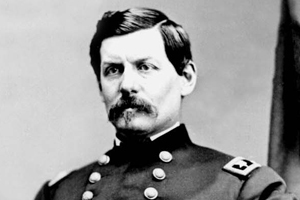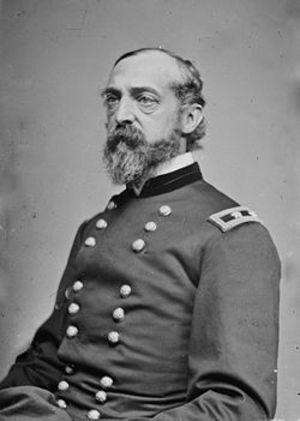The Civil War, as with most wars throughout history, had its share of battlefield mistakes. Whether by miscommunication, incompetence, or sheer misfortune, both Union and Confederate commanders committed numerous tactical blunders-often with devastating consequences for the troops involved. In five particular instances, the resulting casualties have made these Civil War battles case studies in bad military judgment.
McClellan at Antietam (1862)
In September of 1862, Robert E. Lee led 40,000 Confederate soldiers into Maryland in an attempt to bring the war to the North. Standing against him was the Army of the Potomac, commanded by George McClellan. During the march, Lee divided his force, sending Stonewall Jackson with half his army to Harper’s Ferry to capture the Union garrison there and protect his supply line. On September 13, a Union corporal stumbled upon a piece of paper wrapping three cigars in an abandoned Confederate camp. It was a copy of Lee’s orders with details on his army, its deployments, and the objectives. McClellan realized exactly what Lee was up to and told his aides, “Here is a paper with which, if I cannot whip Bobbie Lee, I am willing to go home.” And then, in typical McClellan fashion, the general convinced himself that his 95,000 troops were outnumbered by 18,000 Confederates.
McClellan first advanced on the Rebel positions on September 15, and waited another two days to begin the assault. It allowed Jackson to rejoin Lee and doubled his numbers. A quicker attack with all the available Union force might have destroyed the heart of the Confederate army and possibly ended the war. Instead, the ensuing twelve-hour battle on September 17 effectively resulted in a stalemate with 23,000 casualties between the two sides. Lee withdrew the next day; McClellan took over a month to follow Lee back across the Potomac. Some historians estimate that McClellan’s conduct at Antietam added as many as two years to the war. In early November, an exasperated Lincoln relieved McClellan of his command and indeed sent him home for the rest of the war.
Burnside at Fredericksburg (1862)
General Ambrose Burnside took over command of the Army of the Potomac in November of 1862 following McClellan’s removal. The failures of the Union army over the past year left Lincoln craving a victory to maintain public confidence. Burnside devised an offensive campaign aimed at confusing Lee and assaulting the Confederate capital of Richmond, Virginia. A key part of the plan was to cross the Rappahannock River at Fredericksburg.
Things immediately went wrong as the necessary pontoon bridges for the river crossing arrived two weeks later than Burnside’s army. It gave Lee time to make a defensive stand against the Union forces. Burnside’s army finally began crossing the Rappahannock en masse by December 12, and the attack commenced on December 13. A Union division nearly broke through the Rebel lines to the south but was repulsed by a strong counterattack. On the western ridge of Marye’s Heights, however, Burnside’s orders and stubborn determination to take the ridge led to a massacre under withering Confederate rifle and artillery fire. In one afternoon of fighting, seven Union divisions were decimated in 14 futile charges. On December 15, Burnside withdrew back across the Rappahannock after losing more than 12,000 men against Confederate casualties of just over 5,000. By January, Lincoln had reassigned the overmatched Burnside to command of the Ninth Corps in Ohio.
Hooker at Chancellorsville (1863)
In late April of 1862, newly appointed Joseph Hooker led the Army of the Potomac back toward Fredericksburg with a bold new plan for confronting Lee’s army. His cavalry would raid deep behind Lee to disrupt supply lines and communication with Richmond. While this was going on, Hooker envisioned a pincer movement, with part of his army marching around Lee to strike from the rear and pinning the Confederate army as the rest of his troops made a frontal assault at Fredericksburg.
Instead, George Stoneman’s cavalry was delayed by two weeks and achieved none of its military objectives. Then Lee went against one of the first rules of war by dividing his force in the presence of a numerically superior enemy to confront Hooker’s flanking force near Chancellorsville. Hooker immediately went on the defensive, and Lee yet again split his army with a wide march that routed the Union right flank. To make matters worse, Hooker suffered a concussion when a cannonball struck a pillar he was leaning against, impairing him for the latter part of the battle. The resulting indecision and miscommunication between Union forces helped Lee to a masterful victory against a force more than twice his size, albeit at the heavy price of more than 30,000 casualties between the two armies. Hooker was eventually relieved of his command days before the pivotal battle at Gettysburg.
Lee at Gettysburg (1863)
Lee’s second attempted northern offensive was aimed at giving Pennsylvania some of the same treatment that his native Virginia had suffered. Politically, it was meant to make the North even wearier of a war that no one thought should have lasted so long. Throughout June, Lee’s army marched steadily northward with the Army of the Potomac tracking along, interposed between the Confederates and Washington D.C. The two armies eventually converged at the town of Gettysburg in the largest battle ever fought on American soil.
After two days of bloody fighting trying to turn the Union flanks, Lee ordered a frontal attack against the Union center on Cemetery Ridge. Some 12,500 Confederate soldiers made the charge over three-quarters of a mile of open terrain. More than half were lost in the attempt as the Union troops held them at bay. Later known as “Pickett’s Charge,” it was a bloodbath that only added to casualties Lee could no longer afford. More than 23,000 Confederate soldiers were lost at Gettysburg; Lee limped back to Virginia and would not mount another offensive campaign in the Civil War. The defeat marked a tipping point for the Confederacy in a war of attrition that it simply could not win.
Grant at Cold Harbor (1864)
In the summer of 1864, the new Union general-in-chief Ulysses S. Grant undertook his grinding Overland Campaign as part of the endgame strategy to destroy Lee’s army and seize Richmond. As the Army of the Potomac fought its way southward, reconnaissance reported Rebel forces near the vital crossroads of Cold Harbor. Neither army wanted to cede control of Cold Harbor to the enemy.
Fighting started late on June 1 with little effect. An early morning assault on the Confederate positions was intended for the next day. During the evening, however, the troops counted upon to lead the attack got lost on their march. The assault was first postponed until the afternoon of June 2, then pushed back to the morning of June 3. That bought Lee’s seasoned engineers the time to fortify entrenchments, creating a veritable murder zone. The initial attack resulted in as many as 7,000 Union casualties in less than an hour. By midday, Grant ordered the attacks suspended; by nightfall, he acknowledged his order for the assault as the greatest regret of his career. Grant withstood the hit to his reputation, but Cold Harbor was among the most brutal and bloody errors of the Civil War.
Sources
The Civil War (Bruce Catton, 1987), The Civil War: A History (Harry Hansen, 1991), Civil War Blunders (Clint Johnson, 1997), Library of Congress Digital Collections




